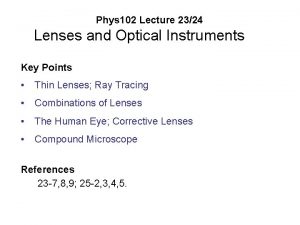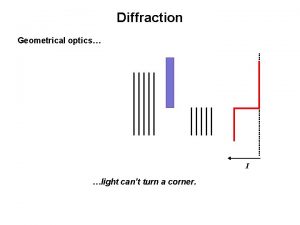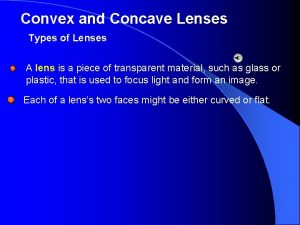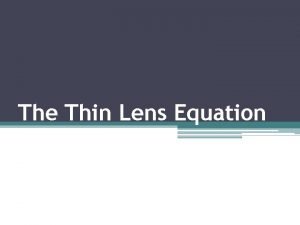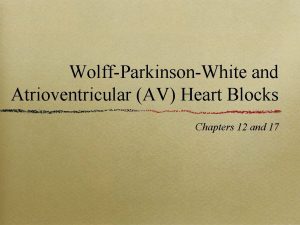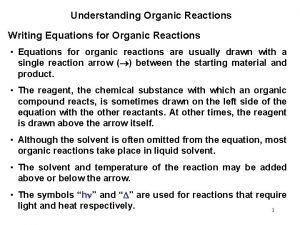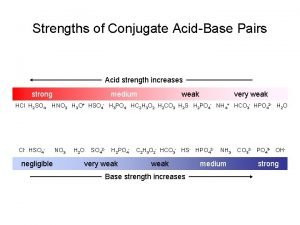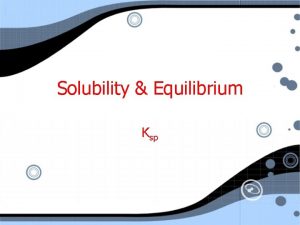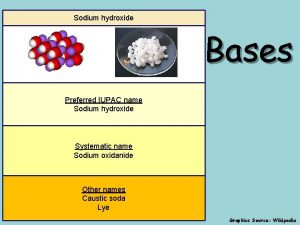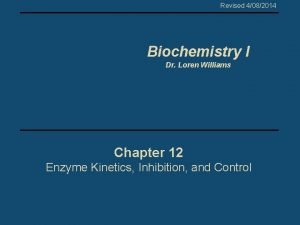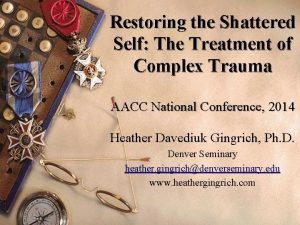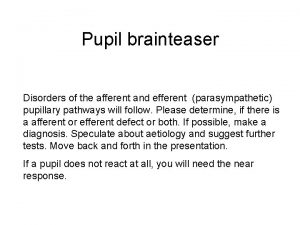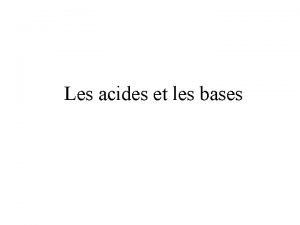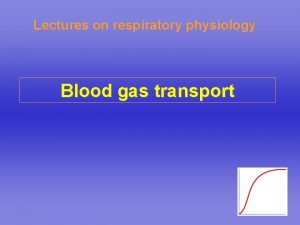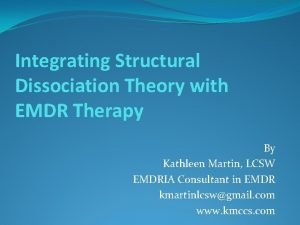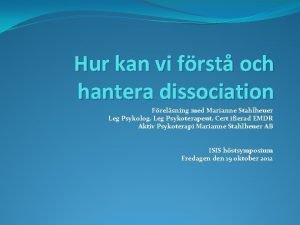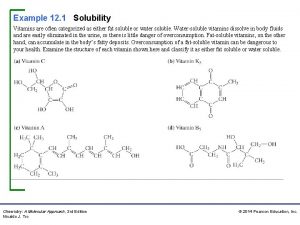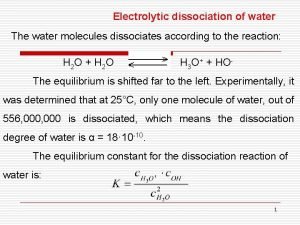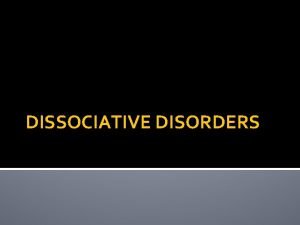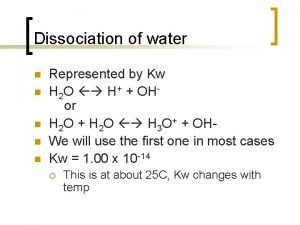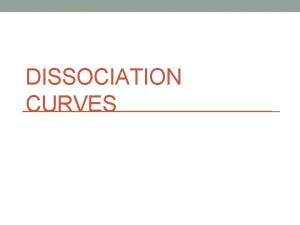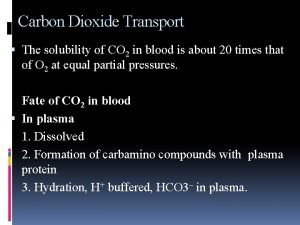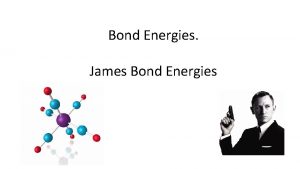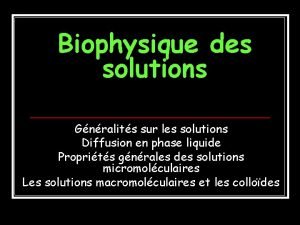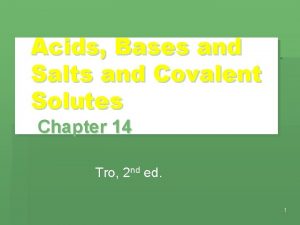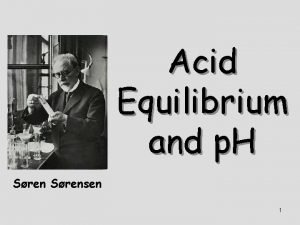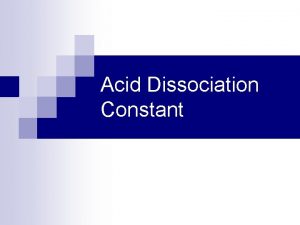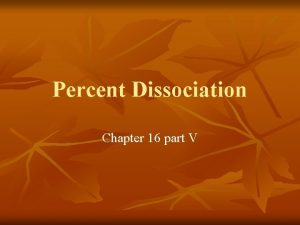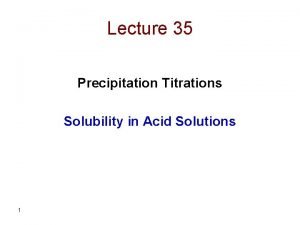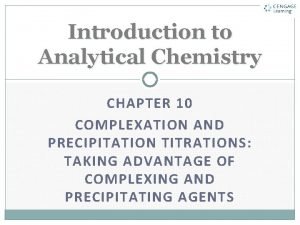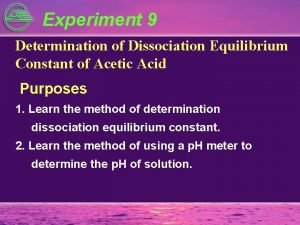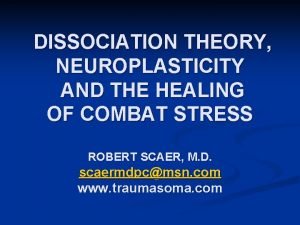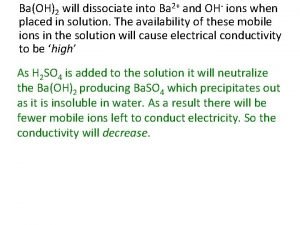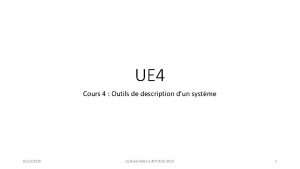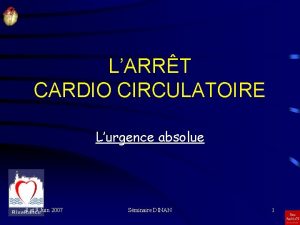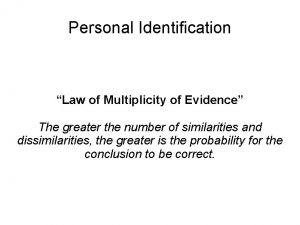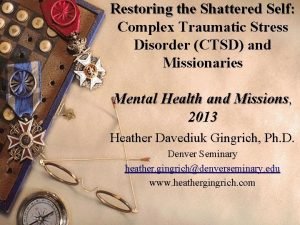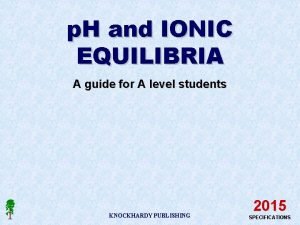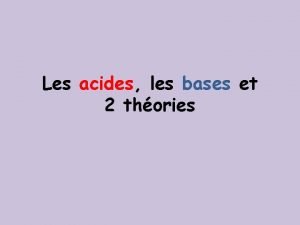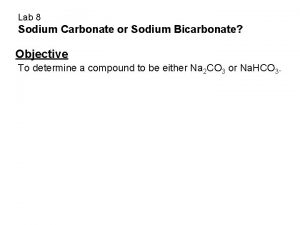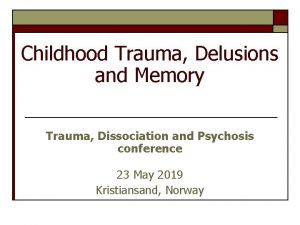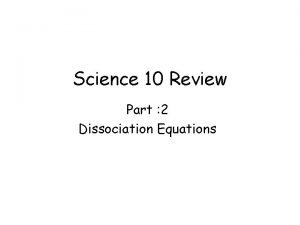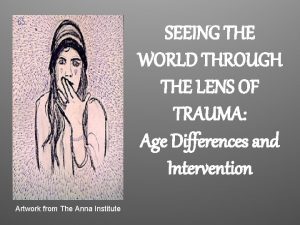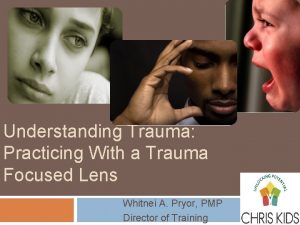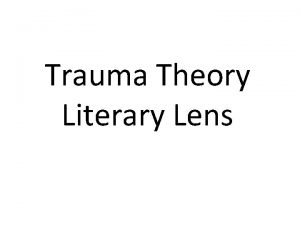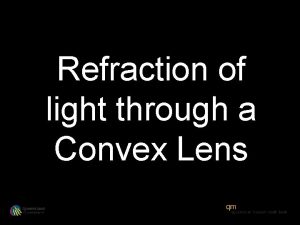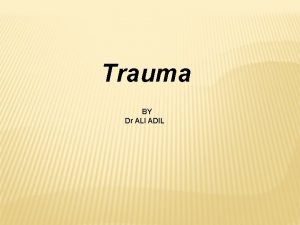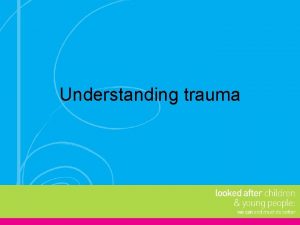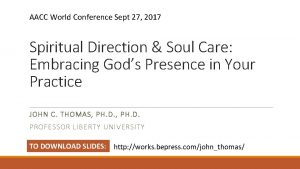TRAUMA THROUGH THE LENS OF DISSOCIATION AACC WORLD




















































- Slides: 52

TRAUMA THROUGH THE LENS OF DISSOCIATION AACC WORLD CONFERENCE – SEPT 28, 2017 Heather Davediuk Gingrich, Ph. D. Denver Seminary

WHAT DO THE FOLLOWING CASES HAVE IN COMMON?

CASE 1 - SANDY Panic disorder

CASE 2 - HALEY Somatic Symptom

CASE 3 - AHMEE Flat affect

REVISITING THE CASES: DISSOCIATIVE EPISODES

SO WHAT?

Recognizing dissociative symptoms Identifying potential trauma

POSTTRAUMATIC SYMPTOMS: INTRUSIVE • memories • dreams • dissociative reactions (e. g. flashbacks) • Distress at exposure to internal or external trauma cues • Physiological reactions to internal or external trauma cues

POSTTRAUMATIC SYMPTOMS: AVOIDANCE • Attempts to avoid exposure to reminders of the trauma, including avoiding: • distressing memories, thoughts or feelings • External reminders (e. g. , people, places etc. )

POSTTRAUMATIC SYMPTOMS: NEGATIVE ALTERATIONS IN COGNITIONS AND MOOD • Amnesia • Persistent and exaggerated negative beliefs or expectations about oneself, others, or the world (e. g. , “I am bad”) • Persistent, distorted cognitions about cause or consequences of traumatic event leading to selfblame or blaming others • Persistent negative emotional state • Diminished interest in significant activities • Feelings of detachment from others • Persistent inability to experience positive emotions

POSTTRAUMATIC SYMPTOMS: ALTERATIONS IN AROUSAL AND REACTIVITY • Irritability (e. g. , verbal or physical aggression) • Reckless or self-destructive behavior • Hypervigilance • Exaggerated startle response • Problems with concentration • Sleep disturbance

DSM-5 PTSD DISSOCIATIVE SUBTYPE • when PTSD is seen with prominent dissociative symptoms • depersonalization • experiences of feeling detached from one’s own mind or body • derealization • experiences in which the world seems unreal, dreamlike or distorted. American Psychiatric Association, 2013

WHY LEARN ABOUT DISSOCIATION? • Dissociative subtype of PTSD in DSM-5 • Used by victims of all kinds of trauma • In addition to the link between peritraumatic dissociation and PTSD, there is a well-documented association between trauma and posttraumatic dissociation (see Gingrich, 2005) • Explanation for why treatment techniques for dissociative disorders can also be helpful for other trauma survivors

DSM-5 -Definition of Dissociation Disruption of and/or discontinuity in the normal integration of consciousness, memory, identity, emotion, perception, body representation, motor control, and behavior. Simply put: Dissociation is compartmentalization, or disconnection among aspects of self and experience

NORMAL VERSUS PATHOLOGICAL DISSOCIATION

CONTINUUM OF DISSOCIATION DISSOCIATIVE EPISODE NORMAL • • hypnosis ego states automatisms childhood imaginary play • • • fear/terror repression highway hypnosis sleepwalking !mystical/ religious experiences (e. g. , meditation, ecstatic experiences) ACUTE STRESS DISORDER (up to 4 wks. ) • • • POST TRAUMATIC STRESS DISORDER (4 weeks +) flashbacks numbness, detachment, absence of emotional response reduced awareness of surroundings (dazed) derealization depersonalization amnesia for aspects of the trauma DISSOCIATIVE DISORDER NOT OTHERWISE SPECIFIED DISSOCIATIVE DISORDER • • • Dissociative • amnesia Dissociative fugue Depersonali- • zation disorder • • DDNOS with features of DID Polyfragmented DDNOS Dissociative trance disorder Possession trance disorder DISSOCIATIVE IDENTITY DISORDER • • DID Polyfragmented DID Adapted from Braun, B. G. (1988)

BASK MODEL OF DISSOCIATION (Braun, 1988)

COMPONENTS OF EXPERIENCE/MEMORY BASK MODEL OF DISSOCIATION • Behavior • Affect (emotions) • Sensation (physical) • Knowledge Full, integrated memory includes all four reassociated components. (Braun, 1988)

BASK - KNOWLEDGE • A trauma survivor has full or partial cognitive knowledge of traumatic event(s) • Cognitive knowledge of the trauma is dissociated from behavior, affect and sensation • Generally what people mean when they say “I remember”

BASK - BEHAVIOR • Behavior is dissociated from other aspects of memory • Individual acts in a certain manner without knowing why • Examples: -war vet avoiding 4 th of July fireworks -sexual abuse survivor vomiting after sexual intercourse -avoidance of intimate relationships

BASK - AFFECT • Affect is dissociated from other aspects of memory • Example: feeling of anxiety for no apparent reason

3: 48 A. M. I awake and it’s 3: 48 in the morning, and the anxiety runs through my body, and I feel so empty… The overwhelming feeling of loneliness is overpowering, and I try to push my mind to try to think what am I waking up for… Emptiness and loneliness…

3: 48 A. M. (CONTINUED) Then I remember, I know why I am awake and it brings pain, and it burns into the darkness of the black laughter, I know, it’s when my father left me not just physically, but emotionally too, with the guilt, the responsibility, not saying a word, he would just leave, and I’m left with the loneliness and pain…

BASK – AFFECT (CONTINUED) • Affect is dissociated from other aspects of memory - e. g. , feeling of anxiety for no apparent reason • There are no feelings attached to the cognitive knowledge of the memory - flat affect - matter-of-fact tone of voice - e. g. , can talk about being raped as though discussing the heat of the coming summer


BASK - SENSATION • Physical sensation is dissociated from other aspects of memory • Individual may have cognitive knowledge of trauma, be aware of related affect, and understand some behavior, but not remember the pain (or pleasure) associated with the trauma • Examples: -body memories – physical symptoms such as bleeding or severe pain occur in the present but are unexplained -sexual excitement

BASK Model Behavior Affect Sensation Knowledge Gingrich (2013)

DISSOCIATIVE SYMPTOMS • Amnesia • Depersonalization • Derealization • Identity confusion • Identity alteration

CASE STUDY OF MEL

Amnesia A specific and significant block of time that has passed but that cannot be accounted for by memory • • • persistently experiences difficulty with her memory can’t remember periods of time from the past or present these gaps happen “almost all the time” forgets friends’ names, her professors’ names, doesn’t remember meeting classmates forgets her age struggles to remember to do her daily activities can’t remember what she has studied when she writes multiple choice exams “I’m very good at guessing the answers” almost forgot to come to her interview (despite reminder)

Depersonalization Sense of detachment from one’s self, e. g. , a sense of looking at one’s self as if one is an outsider • when she draws or paints it is “like I was painting, but the strokes don’t come from me” • finished product is not typical of her usual style • when she writes, she does not feel as though she is the one in control of the writing • “OK, why did I write these things? The feeling was a different feeling - I felt different. . . It’s like a continuous flow, and I keep on ranting about things, and I wasn’t thinking. I don’t know - it’s like [my] hand moving and - I don’t know” • “I was able to write good poems, and even earn” (1 of 2)

Depersonalization Sense of detachment from one’s self, e. g. , a sense of looking at one’s self as if one is an outsider • has emotional outbursts, or rapid changes in mood that feel out of her control, and unlike her usual self • experiences bangungot “a lot, ” finding herself unable to move her arms and legs, while soundlessly screaming • sometimes sees her hands and feet as though from a different perspective; as though “my neck should be higher [from my current position] in order to receive that kind of angle” (2 of 2)

Derealization A feeling that one’s surroundings are strange or unreal. • told by her family that she slept during class during most of kindergarten and grandfather had to take down her class notes • “I know I wasn’t asleep. . I felt like I’m awake…the classroom was different. . . it was like cloudy” • sometimes “everything turned black” and “suddenly I can’t hear things” for a few seconds, until surroundings slowly appear again

Identity Confusion Subjective feelings of uncertainty, puzzlement, or conflict about one’s identity • feels continually confused about who she is • • struggles with what she really wants experiences chest pains and headaches in the effort to sort it all out • frequently imagines herself as another person in another world, as a way of trying to figure out if she would be happier as a different person doing different things from what she does now

Identity Alteration Objective behavior indicating the assumption of different identities or ego states, much more distinct than different roles • frequently gets feedback from others that she seems like a different person • sometimes feels as though she is a different person • often finds things such as towels, pencils and even underwear in her possession, as well as noticing numbers in her cell phone directory that she neither recognizes, nor remembers putting there • often feels younger than her age - often 14, or below 8 years • not interested in guys, wearing make up or accessories, or reading the magazines other girls her age like to read (1 of 2) “I’m more into comic books - I’m totally different”

Identity Alteration Objective behavior indicating the assumption of different identities or ego states, much more distinct than different roles • “I act really childish sometimes. . . Until right now I would want to play. I’d play actually. I play with toys for 3 year olds and still - I like video games a lot, going to arcades and stuff” • associates name Roland with feeling 14 • when feels like Roland, “I’m a bit boyish” • Roland is happy and carefree, and is creative • associates name Mimi with feeling 8 or younger • Mimi has tantrums • 17 year old Mel is composed, silent and responsible (2 of 2)

DISSOCIATIVE SYMPTOMS AS THEY RELATE TO POSTTRAUMATIC SYMPTOMS

FULL FLASHBACKS • Intrusive posttraumatic symptom • Feels as though the trauma is being fully reexperienced in the present • Not aware of the here-and-now • Can be seem as result of dissociated aspects of experience being triggered into awareness • All 4 BASK components being triggered at once • All 5 dissociative symptom areas being triggered

PARTIAL FLASHBACKS BASK • Survivor is not fully lost in the trauma memory • Some BASK components still dissociated • E. g. , could take form of recurrent terrifying visual images • A and K BASK components reexperienced leading to potential hyperarousal • B and S components still dissociated (avoidance)

NIGHTMARES • Also intrusive, reexperiencing; can be similar to flashbacks • Full trauma reenactment involves all BASK components • In some, content may differ • E. g. , terror of being chased by a monster is actually A being reexperienced but K being dissociated (because monster represents an aspect of the trauma, e. g. , abuse perpetrator).

DIFFICULTIES WITH AFFECT REGULATION • Trauma survivors tend to be either flooded with emotion or have blunted affect • Overwhelming emotion is an intrusive posttraumatic (re-experiencing) symptom • Restricted affect is part of posttraumatic avoidance • Both can involved dissociated A from BASK

BODY MEMORIES • Related to the S component of BASK • Is somatoform dissociation • Examples are: physical pain, pleasure, marks on skin, unexplained bruising and bleeding.

WHAT DO YOU SUGGEST I DO?

CLINICAL APPLICATION: INFORMAL AND FORMAL ASSESSMENT FOR DISSOCIATION • Notice dissociated BASK components • Look for DSM-5 dissociative symptoms • Use a screening instrument for dissociation (e. g. , DES-II) • Use a diagnostic instrument (e. g. , SCID-D -R)

ASSESSMENT INSTRUMENTS: DISSOCIATION • Somataform Dissociation Questionnaire (SDQ 5 or SDQ-20) (Nijenhuis, 1999) • Dissociative Experiences Scale-II (DES-II) (Putnam, 1997) • Structured Clinical Interview for DSM-IV Dissociative Disorders-Revised (SCID-D-R) (Steinberg, 1993)

CLINICAL APPLICATION: INFORMAL AND FORMAL ASSESSMENT FOR TRAUMA • Ask about trauma history • Look for posttraumatic symptoms • Use a trauma assessment instrument

CLINICAL APPLICATION: USE OF DISSOCIATIVE ABILITIES TO MANAGE POSTTRAUMATIC SYMPTOMS • Internal contracting • Suicidal behavior • Intrusive posttraumatic symptoms • Pacing of trauma processing • Control of emotional flooding within and outside of sessions • Ability to temporarily keep memories from conscious awareness

www. heathergingrich. com


REFERENCES • American Psychiatric Association (2013). Diagnostic and statistical manual of mental disorders, (5 th ed). Washington, DC: Author. • Braun (1988). The BASK model of dissociation: Clinical applications. Dissociation, 1(2), 16 -23. • Gingrich, H. D. (2005). Trauma and dissociation in the Philippines. In G. F. Rhoades, Jr. and V. Sar (2005), Trauma and dissociation in a crosscultural perspective: Not just a North American phenomenon. New York, NY: Haworth Press. • Gingrich, H. D. (2013). Restoring the shattered self: A Christian counselor’s guide to complex trauma. Downers Grove, IL: Inter. Varsity Press • Nijenhuis, E. R. S. (1999). Somatoform dissociation: Phenomena, measurement, and theoretical issues. Assen, The Netherlands: Van Gorcum. • Putnam, F. W. (1997). Dissociation in children and adolescents: A developmental perspective. New York, NY: Guilford Press. • Steinberg, M. (1993). Structured Clinical Interview for DSM-IV Dissociative Disorders (SCID-D). Washington, DC: American Psychiatric Press.

POWERPOINT PRESENTATION AVAILABLE AT: • www. heathergingrich. com
 Aacc leadership competencies
Aacc leadership competencies Magnification of compound microscope formula
Magnification of compound microscope formula Huygens
Huygens Convex vs concave
Convex vs concave Thin lens equation rearranged
Thin lens equation rearranged Through one man sin entered the world, and through one man
Through one man sin entered the world, and through one man Av dissociation
Av dissociation Bond dissociation energy table
Bond dissociation energy table Hcl ionisation equation
Hcl ionisation equation Iodate solubility
Iodate solubility Sodium oxidanide
Sodium oxidanide Km dissociation constant
Km dissociation constant Restoring the shattered self
Restoring the shattered self Isocoric pupil means
Isocoric pupil means Base conjuguée
Base conjuguée Co2 dissociation curve
Co2 dissociation curve Structural dissociation
Structural dissociation Strukturell dissociation
Strukturell dissociation L'hémolyse physiologique
L'hémolyse physiologique Site:slidetodoc.com
Site:slidetodoc.com Dissociated meaning
Dissociated meaning Dissociative disorder not otherwise specified
Dissociative disorder not otherwise specified Water dissociation
Water dissociation Structure of haemoglobin
Structure of haemoglobin Co2 dissociation curve
Co2 dissociation curve Disassociating adhd
Disassociating adhd Dissociation constant protein
Dissociation constant protein Bond energy table
Bond energy table Po4na3 dissociation
Po4na3 dissociation Chromotagraphie
Chromotagraphie Formula for degree of dissociation
Formula for degree of dissociation Ionization vs dissociation
Ionization vs dissociation Honh2 dissociation equation
Honh2 dissociation equation Dissociation constan
Dissociation constan Lugworm oxygen dissociation curve
Lugworm oxygen dissociation curve Percent dissociation formula
Percent dissociation formula Collision induced dissociation
Collision induced dissociation Agscn dissociation
Agscn dissociation Agscn dissociation
Agscn dissociation Hac kps
Hac kps Dissociation
Dissociation Baoh2 dissociation
Baoh2 dissociation Po4na3 dissociation
Po4na3 dissociation Word equation chemistry
Word equation chemistry Dissociation électromécanique ecg
Dissociation électromécanique ecg Dissociation electrolytique
Dissociation electrolytique Degree of dissociation of electrolyte depends on
Degree of dissociation of electrolyte depends on Example of law of multiplicity
Example of law of multiplicity Syndrome dissociatif
Syndrome dissociatif Bask model of dissociation
Bask model of dissociation Acid dissociation constant
Acid dissociation constant Constante de dissociation
Constante de dissociation Chemical name for sodium carbonate
Chemical name for sodium carbonate

